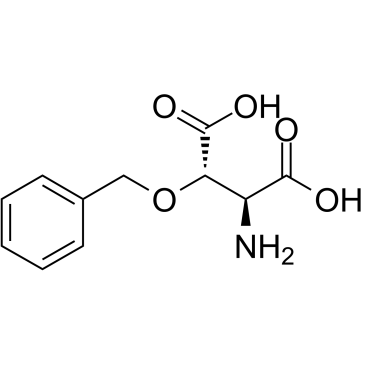205309-81-5
| Name | (3R)-3-(Benzyloxy)-D-aspartic acid-(3S)-3-(benzyloxy)-L-aspartic acid (1:1) |
|---|---|
| Synonyms |
D-Aspartic acid, 3-(phenylmethoxy)-, (3R)-, compd. with L-aspartic acid, 3-(phenylmethoxy)-, (3S)- (1:1)
(3R)-3-(Benzyloxy)-D-aspartic acid - (3S)-3-(benzyloxy)-L-aspartic acid (1:1) |
| Description | DL-TBOA is a potent non-transportable inhibitor of excitatory amino acid transporters with IC50s of 70 μM, 6 μM and 6 μM for excitatory amino acid transporter-1 (EAAT1), EAAT2 and EAAT3, respectively. DL-TBOA inhibits the uptake of [14C]glutamate in COS-1 cells expressing the human EAAT1 and EAAT2 with Ki valuesof 42 μM and 5.7 μM, respectively. DL-TBOA blocks EAAT4 and EAAT5 in a competitive manner with Ki values of 4.4 μM and 3.2 μM, respectively[1][2][3]. |
|---|---|
| Related Catalog | |
| Target |
IC50: 70 μM (EAAT1), 6 μM (EAAT2) and 6 μM (EAAT3); Ki: 42 μM (human EAAT1), 5.7 μM (human EAAT2), 4.4 μM (EAAT4) and 3.2 μM (EAAT5)[1][2][3] |
| In Vitro | DL-TBOA (70-350 μM; 48 hours; HCT116 and LoVo cell lines) treatment concentration-dependently enhances SN38-induced loss of viability. DL-TBOA reversed Oxaliplatin-induced loss of viability[4]. DL-TBOA (350 μM; 24 hours; HCT116 and LoVo cell lines) treatment decreases p53 induction by SN38 and oxaliplatin[4]. Cell Viability Assay[4] Cell Line: HCT116 and LoVo cell lines Concentration: 70 μM or 350 μM Incubation Time: 48 hours Result: Enhanced SN38-induced, and counteracted Oxaliplatin-induced, cell death. Cell Viability Assay[4] Cell Line: HCT116 and LoVo cell lines Concentration: 350 μM Incubation Time: 24 hours Result: p53 induction by SN38 and oxaliplatin was decreased. |
| References |
| Molecular Formula | C11H13NO5 |
|---|---|
| Molecular Weight | 478.449 |
| Exact Mass | 478.158752 |
